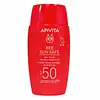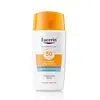What's inside
What's inside
 Key Ingredients
Key Ingredients

 Benefits
Benefits

 Concerns
Concerns

 Ingredients Side-by-side
Ingredients Side-by-side

Water
Skin ConditioningDiethylamino Hydroxybenzoyl Hexyl Benzoate
UV FilterBis-Ethylhexyloxyphenol Methoxyphenyl Triazine
Skin ConditioningEthylhexyl Triazone
UV AbsorberIsoamyl Laurate
EmollientEthylhexyl Salicylate
UV AbsorberTriheptanoin
Skin ConditioningSilica
AbrasiveSorbitol
HumectantC13-15 Alkane
SolventLauryl Glucoside
CleansingPolyglyceryl-2 Dipolyhydroxystearate
Skin ConditioningGlycerin
HumectantParfum
MaskingHelianthus Annuus Seed Oil
EmollientPropolis Extract
Skin ConditioningPanthenol
Skin ConditioningBisabolol
MaskingOlea Europaea Fruit Oil
MaskingRosa Canina Fruit Extract
AstringentSodium Hyaluronate
HumectantAloe Barbadensis Leaf Juice Powder
Skin ConditioningMaris Aqua
HumectantChlorella Vulgaris Extract
Skin ConditioningHydroxypropyl Cyclodextrin
MaskingHydrolyzed Algin
Microcrystalline Cellulose
AbsorbentHydroxyacetophenone
AntioxidantPolyglyceryl-6 Oleate
EmulsifyingTriacontanyl Pvp
HumectantEthylhexylglycerin
Skin ConditioningTocopheryl Acetate
AntioxidantTocopherol
AntioxidantCitronellyl Methylcrotonate
MaskingSodium Stearoyl Glutamate
CleansingCellulose Gum
Emulsion StabilisingCitric Acid
BufferingDisodium EDTA
Xanthan Gum
EmulsifyingWater, Diethylamino Hydroxybenzoyl Hexyl Benzoate, Bis-Ethylhexyloxyphenol Methoxyphenyl Triazine, Ethylhexyl Triazone, Isoamyl Laurate, Ethylhexyl Salicylate, Triheptanoin, Silica, Sorbitol, C13-15 Alkane, Lauryl Glucoside, Polyglyceryl-2 Dipolyhydroxystearate, Glycerin, Parfum, Helianthus Annuus Seed Oil, Propolis Extract, Panthenol, Bisabolol, Olea Europaea Fruit Oil, Rosa Canina Fruit Extract, Sodium Hyaluronate, Aloe Barbadensis Leaf Juice Powder, Maris Aqua, Chlorella Vulgaris Extract, Hydroxypropyl Cyclodextrin, Hydrolyzed Algin, Microcrystalline Cellulose, Hydroxyacetophenone, Polyglyceryl-6 Oleate, Triacontanyl Pvp, Ethylhexylglycerin, Tocopheryl Acetate, Tocopherol, Citronellyl Methylcrotonate, Sodium Stearoyl Glutamate, Cellulose Gum, Citric Acid, Disodium EDTA, Xanthan Gum
Water
Skin ConditioningAlcohol Denat.
AntimicrobialC12-15 Alkyl Benzoate
AntimicrobialButyl Methoxydibenzoylmethane
UV AbsorberBis-Ethylhexyloxyphenol Methoxyphenyl Triazine
Skin ConditioningEthylhexyl Triazone
UV AbsorberButylene Glycol Dicaprylate/Dicaprate
EmollientDibutyl Adipate
EmollientDiethylamino Hydroxybenzoyl Hexyl Benzoate
UV FilterPhenylbenzimidazole Sulfonic Acid
UV AbsorberSilica
AbrasiveTapioca Starch
Polyglyceryl-6 Stearate
EmollientSilica Dimethyl Silylate
EmollientGlycerin
HumectantGlycyrrhiza Inflata Root Extract
Skin ConditioningSodium Hyaluronate
HumectantArginine Hcl
Skin ConditioningSodium PCA
HumectantSodium Lactate
BufferingGlycyrrhetinic Acid
Skin ConditioningCetearyl Alcohol
EmollientGlyceryl Stearate
EmollientCopernicia Cerifera Cera
EmollientPolyglyceryl-6 Behenate
Emulsion StabilisingXanthan Gum
EmulsifyingHydroxypropyl Methylcellulose
Emulsion StabilisingSodium Hydroxide
BufferingTrisodium EDTA
Hydroxyacetophenone
AntioxidantPhenoxyethanol
PreservativeParfum
MaskingWater, Alcohol Denat., C12-15 Alkyl Benzoate, Butyl Methoxydibenzoylmethane, Bis-Ethylhexyloxyphenol Methoxyphenyl Triazine, Ethylhexyl Triazone, Butylene Glycol Dicaprylate/Dicaprate, Dibutyl Adipate, Diethylamino Hydroxybenzoyl Hexyl Benzoate, Phenylbenzimidazole Sulfonic Acid, Silica, Tapioca Starch, Polyglyceryl-6 Stearate, Silica Dimethyl Silylate, Glycerin, Glycyrrhiza Inflata Root Extract, Sodium Hyaluronate, Arginine Hcl, Sodium PCA, Sodium Lactate, Glycyrrhetinic Acid, Cetearyl Alcohol, Glyceryl Stearate, Copernicia Cerifera Cera, Polyglyceryl-6 Behenate, Xanthan Gum, Hydroxypropyl Methylcellulose, Sodium Hydroxide, Trisodium EDTA, Hydroxyacetophenone, Phenoxyethanol, Parfum
 Reviews
Reviews

Ingredients Explained
These ingredients are found in both products.
Ingredients higher up in an ingredient list are typically present in a larger amount.
You might know this ingredient as Tinosorb S or Bemotrizinol. It is a UV filter that covers both UVA and UVB rays.
This ingredient has two peak UV absorption peaks ( 310 and 340 nm) and is able to absorb both UV-A and UV-B rays. This ingredient works by preventing UV rays from reaching and damaging your skin.
On top of that - it is highly photostable and helps prevent the photodegration of other sunscreen ingredients such as avobenzone.
Tinosorb S is allowed in the EU, Australia, and Asia. It is close to being approved by the FDA and we'll hopefully get this ingredient in the U.S. by late 2025.
Fun fact: Tinosorb S is the most effective UV absorber at maximum concentration (measured by SPF) permitted in the EU.
This ingredient is oil-soluble, so your oil-cleansers will take this right off at night.
Learn more about Bis-Ethylhexyloxyphenol Methoxyphenyl TriazineDiethylamino Hydroxybenzoyl Hexyl Benzoate (DHHB) is a chemical UV-A absorber. It is formulated for high UVA protection (320-400 nm).
DHHB is well-liked for:
DHHB has been approved by the EU, Japan, Taiwan, and South America for use up to 10%. Unfortunately, it has not been approved for use in the US or Canada due to slow regulatory processes.
This ingredient is soluble in oils, fats, and lipids.
Learn more about Diethylamino Hydroxybenzoyl Hexyl BenzoateEthylhexyl Triazone is a modern chemical sunscreen that protects from UV-B radiation.
It is the most effective of existing UV-B filters, as it provides the highest level of photo-stable absorption. It protects from the entire UV-B range (280 to 320nm), with it's highest level of protection at 314nm.
Ethylhexyl Triazone is oil soluble, oderless and colorless, which mean it is able to be incorporated into a variety of different formulations.
It is not currently available within the United States due to slow changing FDA regulations. Outside of the US, it is used in formulations at concentrations up to 5%.
Learn more about Ethylhexyl TriazoneGlycerin is already naturally found in your skin. It helps moisturize and protect your skin.
A study from 2016 found glycerin to be more effective as a humectant than AHAs and hyaluronic acid.
As a humectant, it helps the skin stay hydrated by pulling moisture to your skin. The low molecular weight of glycerin allows it to pull moisture into the deeper layers of your skin.
Hydrated skin improves your skin barrier; Your skin barrier helps protect against irritants and bacteria.
Glycerin has also been found to have antimicrobial and antiviral properties. Due to these properties, glycerin is often used in wound and burn treatments.
In cosmetics, glycerin is usually derived from plants such as soybean or palm. However, it can also be sourced from animals, such as tallow or animal fat.
This ingredient is organic, colorless, odorless, and non-toxic.
Glycerin is the name for this ingredient in American English. British English uses Glycerol/Glycerine.
Learn more about GlycerinHydroxyacetophenone is antioxidant with skin conditioning and soothing properties. It also boosts the efficiency of preservatives.
This ingredient is not irritating or sensitizing.
Parfum is a catch-all term for an ingredient or more that is used to give a scent to products.
Also called "fragrance", this ingredient can be a blend of hundreds of chemicals or plant oils. This means every product with "fragrance" or "parfum" in the ingredients list is a different mixture.
For instance, Habanolide is a proprietary trade name for a specific aroma chemical. When used as a fragrance ingredient in cosmetics, most aroma chemicals fall under the broad labeling category of “FRAGRANCE” or “PARFUM” according to EU and US regulations.
The term 'parfum' or 'fragrance' is not regulated in many countries. In many cases, it is up to the brand to define this term.
For instance, many brands choose to label themselves as "fragrance-free" because they are not using synthetic fragrances. However, their products may still contain ingredients such as essential oils that are considered a fragrance by INCI standards.
One example is Calendula flower extract. Calendula is an essential oil that still imparts a scent or 'fragrance'.
Depending on the blend, the ingredients in the mixture can cause allergies and sensitivities on the skin. Some ingredients that are known EU allergens include linalool and citronellol.
Parfum can also be used to mask or cover an unpleasant scent.
The bottom line is: not all fragrances/parfum/ingredients are created equally. If you are worried about fragrances, we recommend taking a closer look at an ingredient. And of course, we always recommend speaking with a professional.
Learn more about ParfumSilica, also known as silicon dioxide, is a naturally occurring mineral. It is used as a fine, spherical, and porous powder in cosmetics.
Though it has exfoliant properties, the function of silica varies depending on the product.
The unique structure of silica enhances the spreadability and adds smoothness, making it a great texture enhancer.
It is also used as an active carrier, emulsifier, and mattifier due to its ability to absorb excess oil.
In some products, tiny microneedles called spicules are made from silica or hydrolyzed sponge. When you rub them in, they lightly polish away dead skin layers and enhance the penetration of active ingredients.
Learn more about SilicaSodium Hyaluronate is hyaluronic acid's salt form. It is commonly derived from the sodium salt of hyaluronic acid.
Like hyaluronic acid, it is great at holding water and acts as a humectant. This makes it a great skin hydrating ingredient.
Sodium Hyaluronate is naturally occurring in our bodies and is mostly found in eye fluid and joints.
These are some other common types of Hyaluronic Acid:
Learn more about Sodium HyaluronateWater. It's the most common cosmetic ingredient of all. You'll usually see it at the top of ingredient lists, meaning that it makes up the largest part of the product.
So why is it so popular? Water most often acts as a solvent - this means that it helps dissolve other ingredients into the formulation.
You'll also recognize water as that liquid we all need to stay alive. If you see this, drink a glass of water. Stay hydrated!
Learn more about WaterXanthan gum is used as a stabilizer and thickener within cosmetic products. It helps give products a sticky, thick feeling - preventing them from being too runny.
On the technical side of things, xanthan gum is a polysaccharide - a combination consisting of multiple sugar molecules bonded together.
Xanthan gum is a pretty common and great ingredient. It is a natural, non-toxic, non-irritating ingredient that is also commonly used in food products.
Learn more about Xanthan Gum